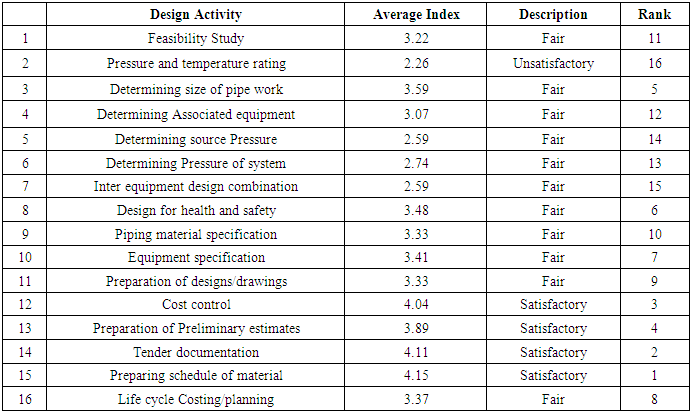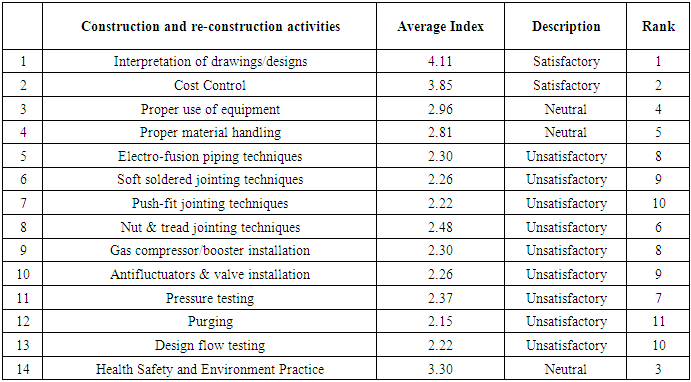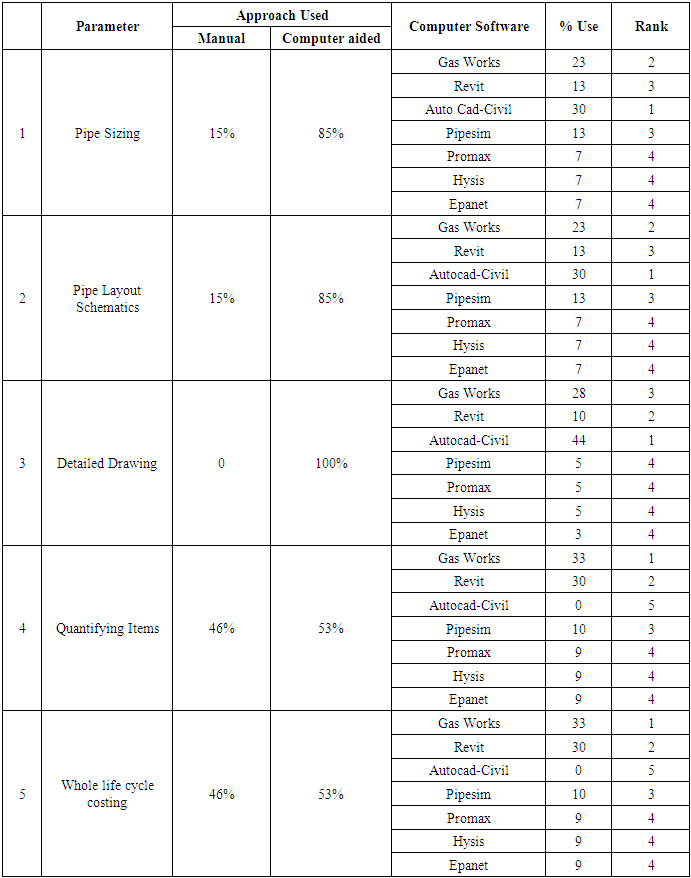-
Paper Information
- Previous Paper
- Paper Submission
-
Journal Information
- About This Journal
- Editorial Board
- Current Issue
- Archive
- Author Guidelines
- Contact Us
International Journal of Construction Engineering and Management
p-ISSN: 2326-1080 e-ISSN: 2326-1102
2018; 7(2): 73-80
doi:10.5923/j.ijcem.20180702.03

Capacity of Local Construction Professionals in Undertaking Natural Gas Downstream Activities in Tanzania
Mbaraka A. Nchimbi, Novatus A. Mikapagaro
Department of Building Economics, Ardhi University, Dar es Salaam, Tanzania
Correspondence to: Novatus A. Mikapagaro, Department of Building Economics, Ardhi University, Dar es Salaam, Tanzania.
| Email: |  |
Copyright © 2018 Scientific & Academic Publishing. All Rights Reserved.
This work is licensed under the Creative Commons Attribution International License (CC BY).
http://creativecommons.org/licenses/by/4.0/

Natural gas exploration in Tanzania has been increasing for the past three years (2013, 2014 and 2015) from 46.5 Trillion Cubic Feet (TFC) in 2014, 50.5 TFC in 2015 and as of 2016, 55.8 TFC respectively. In perspective, such volumes of discovered natural gas have been increasing by a meter (1m) high to cover the area of Tanzania yearly. This shows high natural gas prospects in energy sector inTanzania hence a need to be addressed by the local construction professionals. This study aimed at examining the capacity of local construction professionals (i.e. Architects, Quantity surveyors and Engineers) in undertaking natural gas downstream activities (i.e. design construction and reconstruction) and exploring the challenges faced by local professionals while undertaking those activities. The study was conducted in Dar es Salaam, Tanzania involving Architects, Quantity Surveyors and Engineers working in both consulting and contracting firms. The study found out that, in terms of awareness (knowledge and understanding), local construction professionals are aware of the practice (design and construction) but few have acquired the necessary training regarding the practice. In terms of technical expertise (skills and experience) the study established that, most of the local construction professionals have no necessary technical expertise especially in activities involved. However, most of them proved to be competent in interpretation of designs, cost control, cost estimates and pipe sizing. Main challenges found out by the study are poor enforcement of government policy, poor coordination among project team members and lack of data base on existing utility infrastructures for water and electricity. Conclusively, the capacity of local construction professionals in undertaking natural gas downstream activities is promising in terms of designs and cost control though facing major challenges in technology and organization on construction activities.
Keywords: Capacity, Local Construction Professionals, Natural gas downstream activities
Cite this paper: Mbaraka A. Nchimbi, Novatus A. Mikapagaro, Capacity of Local Construction Professionals in Undertaking Natural Gas Downstream Activities in Tanzania, International Journal of Construction Engineering and Management , Vol. 7 No. 2, 2018, pp. 73-80. doi: 10.5923/j.ijcem.20180702.03.
Article Outline
1. Introduction
- In Tanzania, construction industry is one of the key sectors of the economy. In the first quarter year 2016 the industry grew at a rate of 4.3% compared to 23.28% in the first quarter year 2015. The slowing growth rate was due to reduced investments in the construction activities. The share of the construction sector in the GDP increased to 13.6% in the year 2015 from 7.8% in the year 2010 [11].Natural gas exploration involves upstream, midstream and downstream operations. Upstream and midstream operations include the exploration survey, drilling to obtain the natural gas and transmitting the raw natural gas through pipelines and substations to processing plants and storage yards respectively. Downstream operations on the other hand include distribution of products derived from processing and purifying raw natural gas [12] Different professionals including designers and contractors are involved in each stage of these operations as different demands are being addressed.Downstream gas activities include work by building construction professionals such as designers and contractors who aid in putting up the infrastructure (design and installation) for the delivery of the service (gas) to serve the intended use in the building. This will help make the local construction industry self sustaining; one that is capable of meeting diverse need for construction, rehabilitation and maintenance work efficiently and effectively [2].In the United kingdom, most gas installation work is undertaken by gas engineers registered with the Gas Safe Register; an overseer of gas installation work and assesses the competence/capacity of the designers and gas engineers in the aspect of gas work that they wish to undertake [14].In Nigeria, local constructional professionals are very much aware of the practices but their participation in the natural gas activities is so little (less than 10%) due to existence of so many hindrances major being institutional problems and deficient infrastructural facilities [9].In Tanzania, local buildings contractors are registered with the Contractors Registration Board (CRB), engineers with the Engineers Registration Board (ERB) where as local designers (Quantity surveyors and Architects) are registered with the Architects and Quantity Surveyors Registration Board (AQRB) as required by law. This ensures that the local designers and contractors offer quality and regulated services [1, 3, 4].In the natural gas distribution, The Energy and Water Regulatory Authority (EWURA), carries out health, safety and environmental monitoring of distribution activities in the natural gas which also involves technical inspection [5].Natural gas in Tanzania is anticipated to contribute greatly to the socio-economic development of the country due to its large reservoirs. This can be achieved by, inter alia, rationalizing the exploitation of its oil and gas industry resource and increased local participation in the value chain [7].The local content policy of Tanzania for oil and gas stipulates that the government emphasizes the inclusion of local/ native stake holders in every aspect of the value chain in the oil and gas sector (MEM, ibid). As great technologies are involved in the natural gas downstream operations; distribution of the natural gas product, the local construction industry is in no doubt faced with the challenge of bringing/delivering this gas service to different users. Three local companies actively engaged in natural gas downstream operations namely Tanzania Petroleum Development Corporation (TPDC), Songas Limited (Songas), Pan African Energy Tanzania Limited (PAET).The participation of local construction personnel in the gas sector has been so far the provision of supporting infrastructure (accommodation construction, road works etc.) for the exploration and transportation natural gas activities. [10]. Due to the sophisticated technologies involved in the lately going on exploration activities (onshore and off shore activities) by international companies such as British Gas (BG) and Stat Oil to mention but a few, the participation of the local construction professionals in the natural gas sector seems to be lagging.On this note, the capacity of the local construction professionals (designers and contractors) in gas distribution activities required an assessment in order to ensure that the design, equipment and installation process they offer with regards to gas distribution in different building infrastructure are regulated. This in the long run ensures health and safety in the environment. Furthermore, the local construction industry will be self sustaining; one that is capable of meeting diverse need for construction, rehabilitation and maintenance work efficiently and effectively [2].Understanding the capacity of local construction professionals in undertaking natural gas downstream activities is therefore crucial to effectively achieve the government goals of having a self sustaining and vibrant construction industry. This study therefore aimed at assessing the capacity of local construction professionals in undertaking natural gas downstream activities through examining their awareness (knowledge and understanding), technical expertise (skills and experience) and facilities (tools, plant and equipment) and exploring challenges faced by local construction professionals in those undertakings so that possible measures to enhance their capacity can be proposed.
2. Methodology
- A descriptive research design was adopted as both qualitative and quantitative data were collected and analyzed thus describing the capacity of the local construction professionals in undertaking natural gas downstream activities. The units of analysis were the local construction professionals (Architects, Quantity surveyors, and engineers) in Dar-es-salaam, Tanzania.Stratified non random sampling method was adopted to draw a sample from each category of local construction professionals (i.e. Architects, Quantity Surveyors and Engineers) and thereafter the respondents were conveniently obtained. The population studied consisted of 396 local construction professionals (i.e. 163 Architects, 100 Quantity Surveyors and 133 Engineers). The sample size was obtained based on the following formulae:
 Where:n - Sample sizeD - Level of accuracy (usually ranges between 0.03- 0.05)P - Expected prevalence (usually ranges between 0.01-0.09)Z - Confidence interval ((1-α) = 95% thus Z = 1.96 from normal distribution table)Therefore from n=
Where:n - Sample sizeD - Level of accuracy (usually ranges between 0.03- 0.05)P - Expected prevalence (usually ranges between 0.01-0.09)Z - Confidence interval ((1-α) = 95% thus Z = 1.96 from normal distribution table)Therefore from n=  = (1.96)2 × ((0.04) × (1-0.04)) / (0.05)2= 59.006True/Real sample size =
= (1.96)2 × ((0.04) × (1-0.04)) / (0.05)2= 59.006True/Real sample size =  = 51.4 ≈ 51Sample size in each category of local construction professionals was established as follows:Architects: (163/396) * 51 = 20.99 ≈ 21Quantity Surveyors: (100/396) * 51 = 12.87≈ 13Engineers: (133/396) * 51 = 17.12≈ 17Questionnaire and interview surveys were employed to collect data in which 35 respondents were provided with questionnaires while 15 respondents were interviewed. Both methods were successfully used to obtain data with regard to capacity of (in terms of skills, experience, training, facilities) and challenges facing local construction professionals in undertaking natural gas downstream activities. Binary coding (0 and 1) was used to extract data from the questionnaires to make it easy for analysis using statistical methods.Average index/ mean average method was adopted to measure central tendency since it is simple and straight forward. Average index was calculated based on the following formula:
= 51.4 ≈ 51Sample size in each category of local construction professionals was established as follows:Architects: (163/396) * 51 = 20.99 ≈ 21Quantity Surveyors: (100/396) * 51 = 12.87≈ 13Engineers: (133/396) * 51 = 17.12≈ 17Questionnaire and interview surveys were employed to collect data in which 35 respondents were provided with questionnaires while 15 respondents were interviewed. Both methods were successfully used to obtain data with regard to capacity of (in terms of skills, experience, training, facilities) and challenges facing local construction professionals in undertaking natural gas downstream activities. Binary coding (0 and 1) was used to extract data from the questionnaires to make it easy for analysis using statistical methods.Average index/ mean average method was adopted to measure central tendency since it is simple and straight forward. Average index was calculated based on the following formula:  Where:μ = Weighting given to each factor by the respondents (1 – 6)n = Frequency of respondentsN = Total number of respondentsThe application of the average index in the questionnaire and interview responses was indicated as shown below;μ1=1 Frequency of “Severely lacking” or “Very Useless” responseμ2=2 Frequency of “Unsatisfactory” or “Useless” responseμ3=3 Frequency of “Fairl” responseμ4=4 Frequency of “Satisfactory” or “Highly needed” responseμ5=5 Frequency of “Less lacking” or “Very High” responseμ6=6 Frequency of “Not Lacking” or “Must Have” responseFrom the above, the rating scale would be shown as below;• 1= Severely lacking or Very Useless (1.00 ≤ Average index ≤ 1.50)• 2= Unsatisfactory or Useless (1.50 ≤ Average index ≤ 2.50)• 3= Fair (average) (2.50 ≤ Average index ≤ 3.50)• 4= Satisfactory or Highly needed (3.50 ≤ Average index ≤ 4.50)• 5= Less lacking or Very High (4.50 ≤ Average index ≤ 5.50)• 6=Not Lacking or Must Have (5.50 ≤ Average index ≤ 6.50)
Where:μ = Weighting given to each factor by the respondents (1 – 6)n = Frequency of respondentsN = Total number of respondentsThe application of the average index in the questionnaire and interview responses was indicated as shown below;μ1=1 Frequency of “Severely lacking” or “Very Useless” responseμ2=2 Frequency of “Unsatisfactory” or “Useless” responseμ3=3 Frequency of “Fairl” responseμ4=4 Frequency of “Satisfactory” or “Highly needed” responseμ5=5 Frequency of “Less lacking” or “Very High” responseμ6=6 Frequency of “Not Lacking” or “Must Have” responseFrom the above, the rating scale would be shown as below;• 1= Severely lacking or Very Useless (1.00 ≤ Average index ≤ 1.50)• 2= Unsatisfactory or Useless (1.50 ≤ Average index ≤ 2.50)• 3= Fair (average) (2.50 ≤ Average index ≤ 3.50)• 4= Satisfactory or Highly needed (3.50 ≤ Average index ≤ 4.50)• 5= Less lacking or Very High (4.50 ≤ Average index ≤ 5.50)• 6=Not Lacking or Must Have (5.50 ≤ Average index ≤ 6.50)3. Results
- This study aimed at examining the capacity (knowledge, technical expertise, facilities) of local construction professionals (i.e. Architects, Quantity surveyors and Engineers) in undertaking natural gas downstream activities (i.e. design construction and reconstruction) and exploring the challenges faced by local professionals while undertaking natural gas downstream activities. The study was conducted in Dar es Salaam, Tanzania involving Architects, Quantity Surveyors and Engineers working in consulting and contracting firms.The capacity of local construction professionals in undertaking natural gas downstream activities was examined based on the following parameters: knowledge and understanding, technical expertise and facilities used. The study found out the following:
3.1. Knowledge and Understanding
- This was measured based on respondents’ training, awareness and understanding on definitions, practices and activities involved in natural gas downstream operations as shown in figure 1 below:
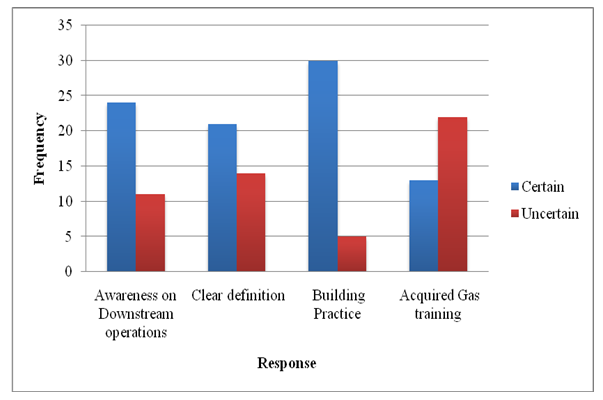 | Figure 1. Local construction professional’s knowledge and understanding on Natural Gas downstream operations |
3.2. Technical Expertise
- This was measured based on respondents’ skills and experience on various activities involved in design, construction and reconstruction in natural gas downstream operations.
3.2.1. Design Activities
- Table 1 below illustrates the results with regard to technical expertise of local construction professionals.
|
3.2.2. Construction and Re-construction Activities
- Table 2 below illustrates the results with regard to technical expertise of local construction professionals.
|
3.3. Facilities
- This was measured based on local construction professionals’ ability to use facilities (i.e. manual or computer aided design tools, plants and equipments) for designing and installation of natural gas downstream work items.
3.3.1. Design Facilities
- Table 3 below illustrates results regarding capacity of local construction professionals to use design facilities.
|
3.3.2. Installation Facilities
- Table 4 below illustrates results regarding capacity of local construction professionals to use installation facilities.
|
3.4. Challenges
- Figure 2 below illustrates the results regarding the challenges encountered by local construction professionals while implementing natural gas downstream activities.
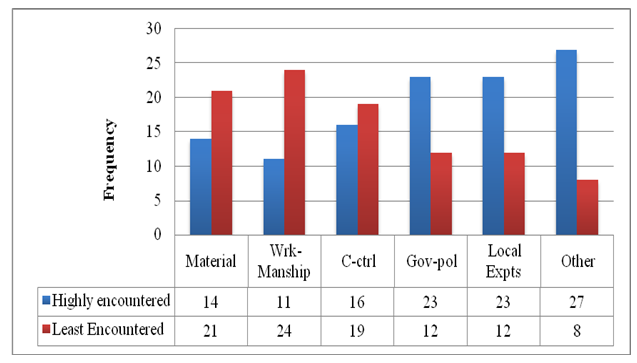 | Figure 2. Challenges encountered by local construction professionals in natural gas downstream operations |
4. Discussion
4.1. Knowledge and Understanding
- Despite the fact that local construction professionals did not acquire specific training on natural gas downstream activities, they demonstrated high understanding and knowledge on the natural gas downstream practices. Most of them were able to clearly define various activities involved in natural gas downstream. This implies that, there are avenues/ forums from which local construction professionals enhance their knowledge and understanding on the natural gas downstream operations in Tanzania.
4.2. Technical Expertise
- Local construction professionals demonstrated fair (average) and satisfactory (enough) level of skills and experience in most of the design related and cost related activities in natural gas downstream respectively. This implies that most of the designers (Architects and Engineers) lack necessary skills and experience in designing and specifying for various items in natural gas downstream operations. On the other side, Quantity Surveyors demonstrate satisfactory skills and experience in quantification and estimating for various items in natural gas downstream operations.In the construction and re-construction stage, local professionals (working in contractors) have unsatisfactory skills and experience in carrying out most of the activities in the natural gas downstream operations. This implies that, most of local professionals do lack necessary expertise for performing certain activities in the natural gas downstream operations. On the other side, local professionals have satisfactory level of skills and experience in design interpretations and cost control activities.In terms of facilities, during design stage, the extent of usage of computer based facilities is higher than manual based facilities. This implies that local professionals possess satisfactory skills and experience in using computer programs for designing of various items in natural gas downstream operations. Local professionals seem to make better use of the current technological advancement to enhance their undertakings in the gas industry. Moreover, during construction stage, local professionals demonstrate satisfactory usage of equipments in performing various activities in the natural gas downstream operations. This implies that, local professionals possess necessary skills and experience in operating equipments to perform various tasks.
4.3. Challenges
- Local construction professionals face several challenges in undertaking natural gas downstream activities. Major challenges are insufficient expertise, poor enforcement of local content policy, lack of data base on existing utility infrastructures for water and electricity and poor coordination among professionals. Most of local construction professionals did not acquire specific training on natural gas downstream activities that is why they lack necessary expertise hence insufficient local experts in this field. Few local professionals having such expertise got opportunities to affiliate with multinational companies undertaking natural gas operations.In order to enhance skills, experience and coordination among local construction professionals, education should be provided through workshops and seminars. Also, more collaboration between local professionals and foreign companies involved in natural gas activities is highly emphasized for gaining organizational and coordination skills [9].The local content policy of Tanzania for oil and gas stipulates that the government emphasizes the inclusion of local/ native stake holders in every aspect of the value chain in the oil and gas sector. Enforcement of the policy has not been as expected because inclusion of local construction professionals in terms of attachment with multinational companies undertaking natural gas operations is very minimal. This contributes much to the lack of necessary expertise by the local professionals.In order to achieve the required local content as stipulated by the local content policy, government monitoring agencies should be both technically and financially empowered so that they take more actions than words [9].Lack of database on existing utility infrastructure for water and electricity hinder smooth operations of natural gas downstream activities. This is due to the fact that natural gas downstream activities involve excavation of trenches for pipe work, in areas where there are no signs showing passage of water pipelines or electrical cables, damages occur and lead to losses and time wastage.
5. Conclusions
5.1. Capacity of Local Construction Professionals
- The capacity of local construction professionals in undertaking natural gas downstream activities can be concluded as follows:• Local construction professionals (Architects, Quantity Surveyors and Engineers) have satisfactory knowledge and understanding of various activities involved in natural gas downstream operations although most of them were not specifically trained in that field. • Local construction professionals (Architects and Engineers) lack necessary expertise (skills and experience) in designing and specifying for various work items involved in natural gas downstream operations. However, local professionals (Quantity Surveyors and Engineers) have satisfactory expertise in quantification and estimation for work items involved in natural gas downstream operations.• Local contractors lack necessary expertise for constructing and repairing of various work items involved in natural gas downstream operations.• Local construction professionals (Architects, Engineers and Quantity Surveyors) possess satisfactory expertise in using facilities (particularly computer aided equipments) for designing and quantifying of various work items involved in the natural gas downstream operations.• Local contractors possess necessary expertise in using and operating tools and equipments for installations of various work items involved in natural gas downstream.
5.2. Challenges faced by Local Construction Professionals
- Challenges encountered by local construction professionals while undertaking natural gas downstream operations include but not limited to the following:• Poor enforcement of government regulations and policies (particularly local content policy) • Lack of data base on existing utility infrastructure (water pipelines and electrical cables)• Poor coordination among local construction professionals
 Abstract
Abstract Reference
Reference Full-Text PDF
Full-Text PDF Full-text HTML
Full-text HTML